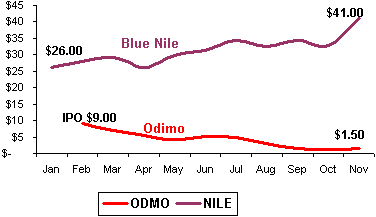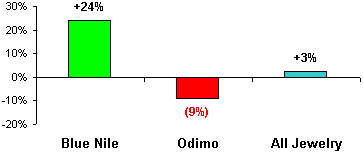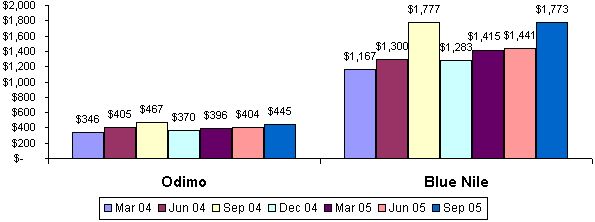IDEX Online Research: Blue Nile & Odimo: A Stark Contrast
November 22, 05
Results for two of the major online jewelry retailers presented a stark contrast for the three months ended September, 2005.
| Online Jewelry Retailers |
This divergence in performance hasn’t gone unnoticed by Wall Street. Since the beginning of the year,
2005 Stock Price - Blue Nile vs Odimo Source: Stock Exchanges |
The following table summarizes financial results for both
| Online Jewelry Retailers' Results
Source: Company Reports |
Revenue Drivers Differ
Blue Nile
Blue Nile has positioned itself as “the online diamond source.” At the time of its initial public offering in May 2004, at least 82 percent of the company’s sales were derived from engagement diamonds (75 percent) and other diamond jewelry (7 percent). As a result, its average ticket is a sky-high $1,400, and reached over $1,700 in the most recent quarter.
In the September quarter, sales at Blue Nile were driven by several categories, including the following:
- Diamond engagement rings
- Wedding bands
- Diamond earrings & pendants
- Pearls & gemstones
- Customized diamond jewelry
The engagement ring category was by far the largest portion of the company’s sales mix in the September quarter, in part because there was no major holiday – such as Valentine’s or Mother’s Day – driving demand for non-engagement jewelry. Last year, Blue Nile’s average ticket for an engagement ring was $5,558, more than twice as high as the average of $2,600 for the typical U.S. consumer’s engagement ring. Wedding bands experienced the greatest unit growth in the quarter at Blue Nile.
In the September quarter,
| Average Ticket - Blue Nile vs Odimo |
Odimo
Odimo, on the other hand, has a much broader product mix, which includes not only diamonds, but fine jewelry, brand name watches, and luxury goods. Much of Odimo’s product line consists of so-called grey market goods – branded merchandise that is trans-shipped against manufacturers’ distribution rules from legitimate sources to Odimo.
Because Odimo’s product mix is much less weighted toward diamond engagement rings, its average ticket is around $400. In the most recent quarter, it was $445, down about 5 percent from the prior year.
Unfortunately, in addition to a lower average ticket, Odimo’s total number of orders declined by about 4 percent in the quarter. Worse yet, the number of visitors to Odimo’s web sites declined by over 32 percent in the three-month period ended September.
Total sales were down nearly 9 percent in the quarter. By product category, Odimo’s sales performance in the September quarter was as follows:
- Diamonds and jewelry – sales down 4 percent
- Watches and luxury goods – sales down 13 percent
Odimo management noted that the decrease in total orders resulted from a large decrease in demand for luxury goods, which was partially offset by an increase in jewelry units.
The Power of Sales Leverage on Costs
Strong sales make life easy for management. Weak sales make life miserable. Sales have the same impact on financial results. When sales are strong, relatively fixed overhead costs are efficiently absorbed. When sales are weak, management is caught in a struggle to cut costs or to wait out a weak period in hopes of stronger demand in the future. Either alternative is stressful.
Blue Nile
Odimo
Odimo had the opposite results: its gross margin fell substantially and its operating cost ratio rose sharply. For the quarter, Odimo’s gross margin declined to 22.3 percent from last year’s 28 percent. Management said that increased promotional discounts related to luxury products sold on its ashford.com site hurt margins. Operating costs rose to 50.7 percent of sales versus 45.3 percent last year. Fulfillment costs declined, modestly as a percentage of sales due primarily to consolidation of fulfillment into one distribution facility. Marketing costs also declined, notably due to reduced online advertising expenditures. Relatively fixed general and administrative costs soared as a percentage of sales and in total dollars.
What’s Next?
Blue Nile
Blue Nile continues to communicate with investors, and the news is good. Annual sales for
Blue Nile has set its sights on overseas markets for its next phase of growth. It recently put up a website targeting U.K. consumers. While volume from this site is less than an estimated $3 million annualized, it is showing solid growth. Blue Nile management also sees opportunities in some other European markets. Italian consumers, for example, are major consumers of large diamond jewelry, but don’t buy much diamond engagement jewelry. Japan is another market that Blue Nile has targeted for expansion.
Odimo
Odimo management was mum on its outlook. In fact, management was mum on the quarter. It filed the required legal documents right at the deadline, and it did not hold its usual conference call for investors. In our opinion, there was probably very little lost by the elimination of its investor conference call. CEO Alan Lipton typically has read the press release word-for-word; on one occasion, an institutional investor chided Lipton for reading the press release without providing additional “color” to the report of results. While Lipton has taken shareholder questions on previous conference calls, answers were brief, without much elaboration.
What’s Causing the Disparity Between Blue Nile and Odimo?
In our opinion, the culture of the two companies could not be more different.
Blue Nile was started by Mark Vadon, a young techie who saw the opportunity that online jewelry offered. He had no real experience in the jewelry industry. Unfettered by tradition, he created an economic operating model from scratch. It called for low margins, high volume, and using other people's money via memo inventory. He coupled this inherently successful financial model with knowledgeable, helpful, and unpretentious sales people, a focused product offering, and quick ship. His website design was revolutionary.
Jewelry industry tradition is draped around Odimo’s neck like an albatross. Its operating management has a jewelry background. The Steinmetz brothers, major investors in Odimo, are DTC Sightholders. In our opinion, they are trying to use the traditional jewelry operating model to drive online sales. So far, no one has successfully transferred the traditional jewelry economic model to the Internet.
Further, Odimo does not have a focused product line. In part, this is due to acquisitions such as ashford.com, which really didn’t quite fit. Odimo has made industry insiders unhappy by discounting distribution-controlled brand-name goods. As a result, Odimo is subject to lawsuits by brand owners and their authorized distributors based on infringement claims
But we can’t criticize Odimo for trying. They, like virtually every other store-based jeweler who has tried to sell over the Internet, are meeting resistance. In our opinion, store-based jewelers simply don’t have the culture to sell successfully over the Internet. Even with all of its financial and management firepower, Zale generated about $18 million in online sales last year, a paltry amount for a company with nearly $2.4 billion in annual sales. Sterling Jewelers does not yet sell over the Internet.
In the company’s most recent conference call, Blue Nile chairman Mark Vadon alluded to this cultural divide between online merchants and store-based retailers. He said that operators of physical stores can’t readily convert to online merchants. The biggest barrier, he noted, is the gross margin and inventory turn.
Is A Revolution Coming?
In our opinion, Blue Nile’s financial model could have the same impact on the jewelry industry that Wal-Mart has had on all of retailing: a revolution in the industry’s economic operating model is underway.

